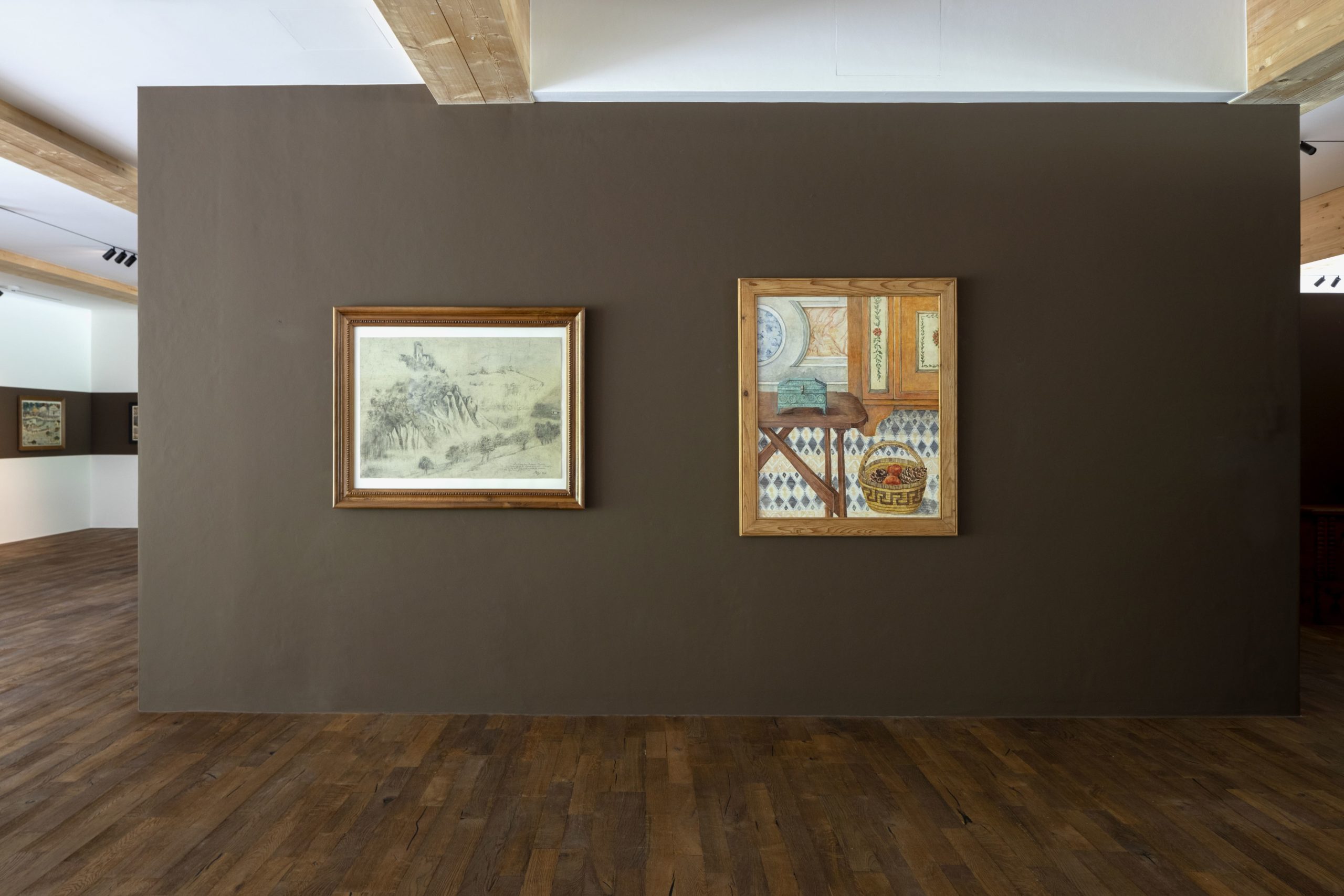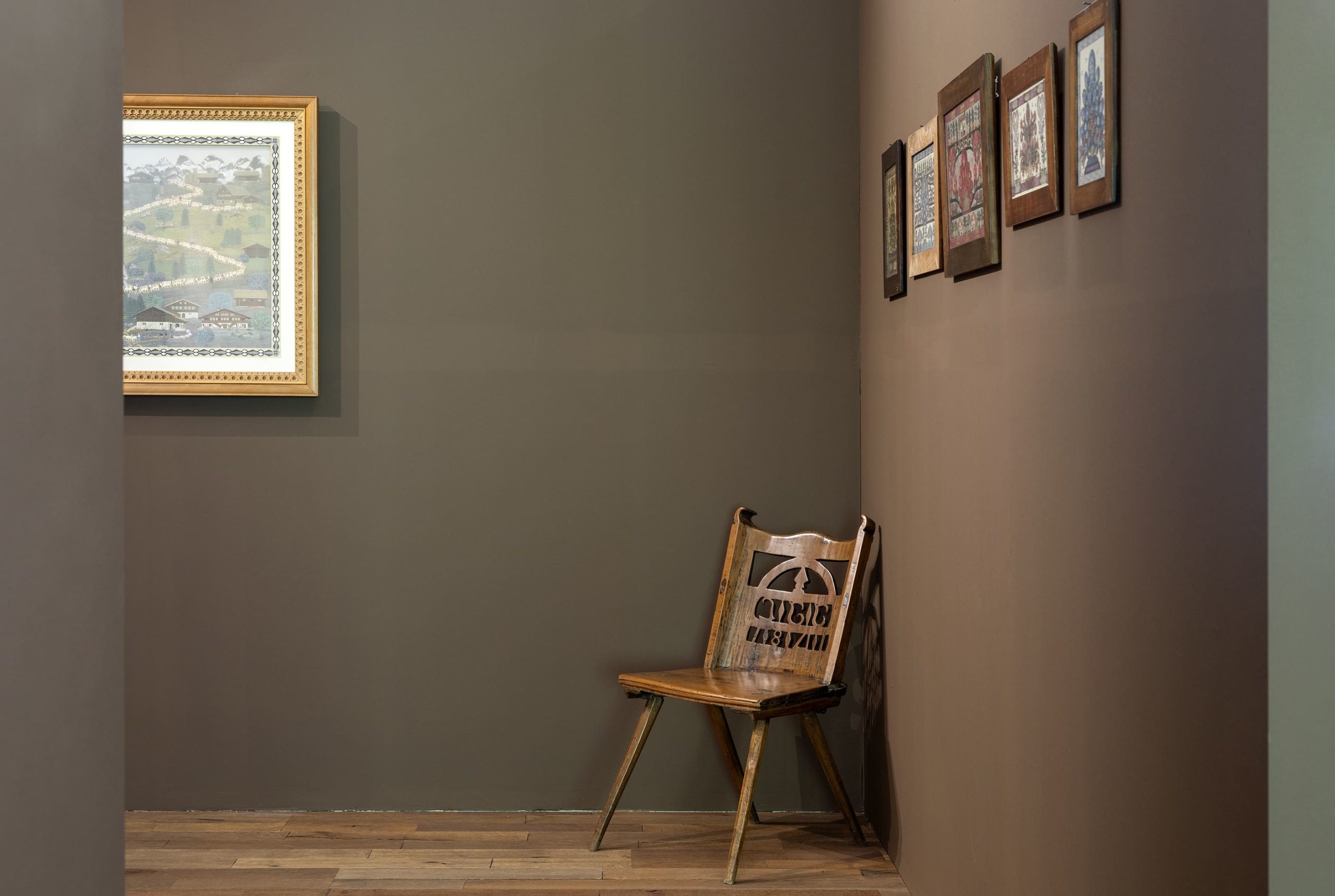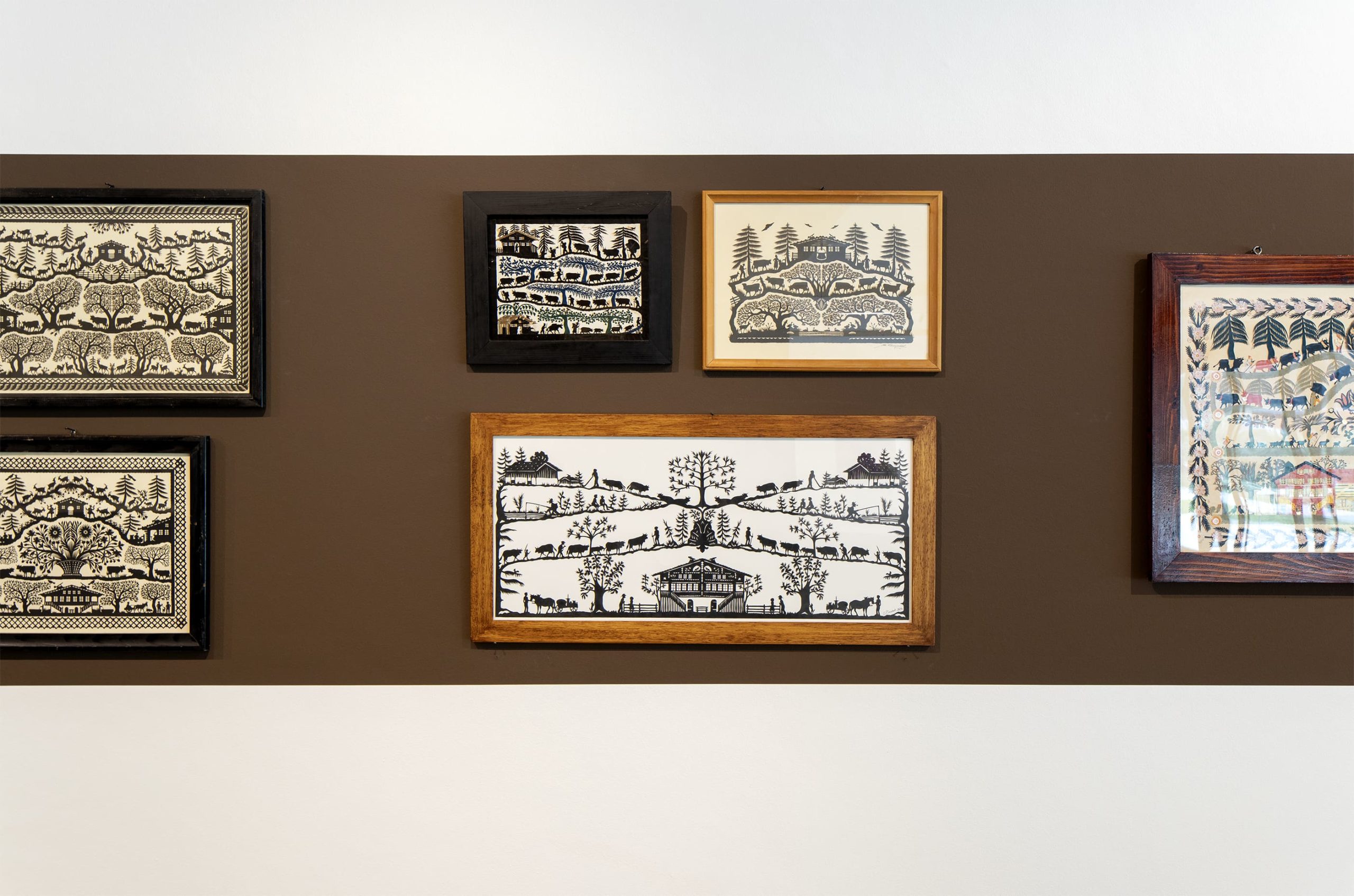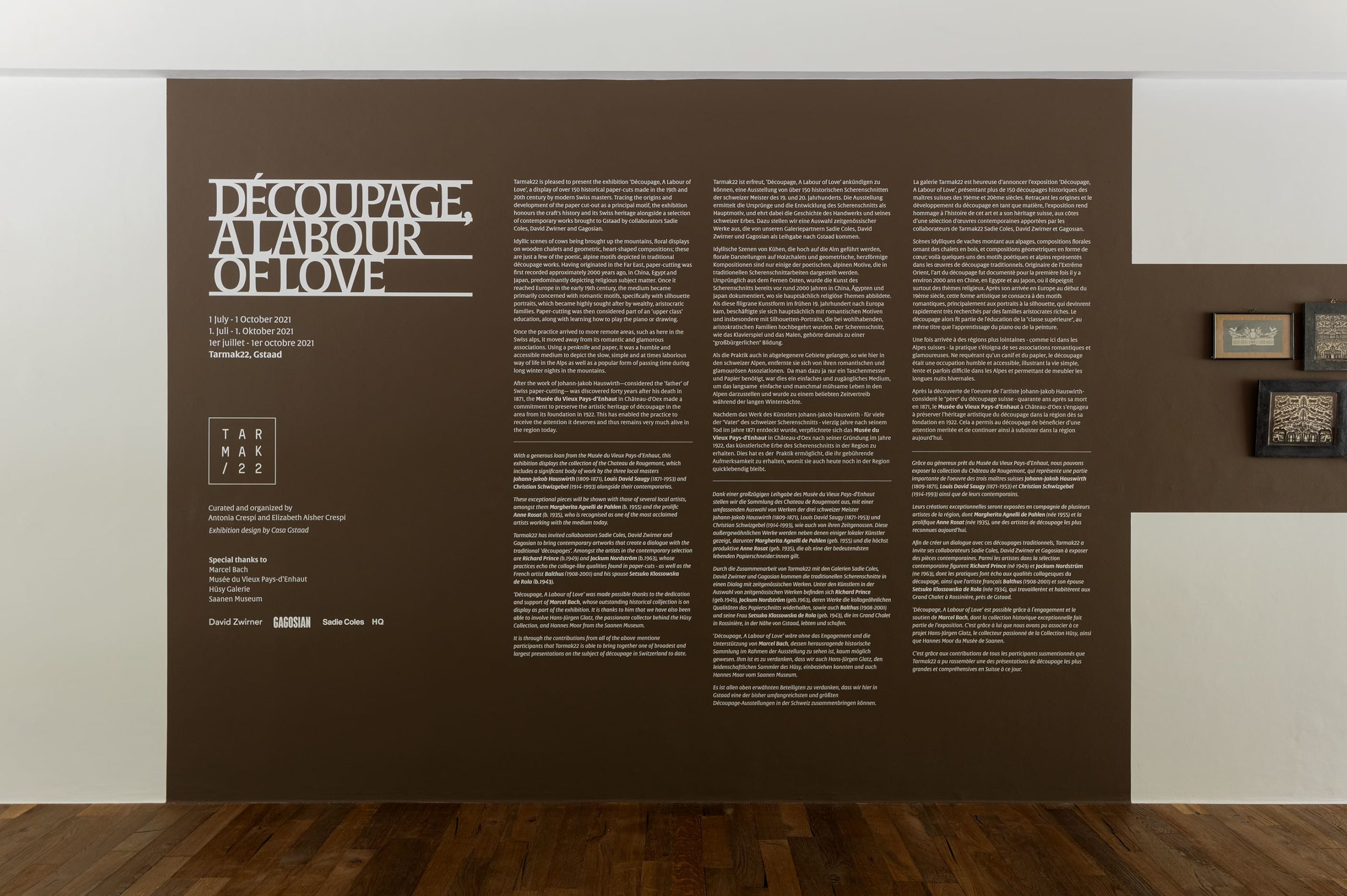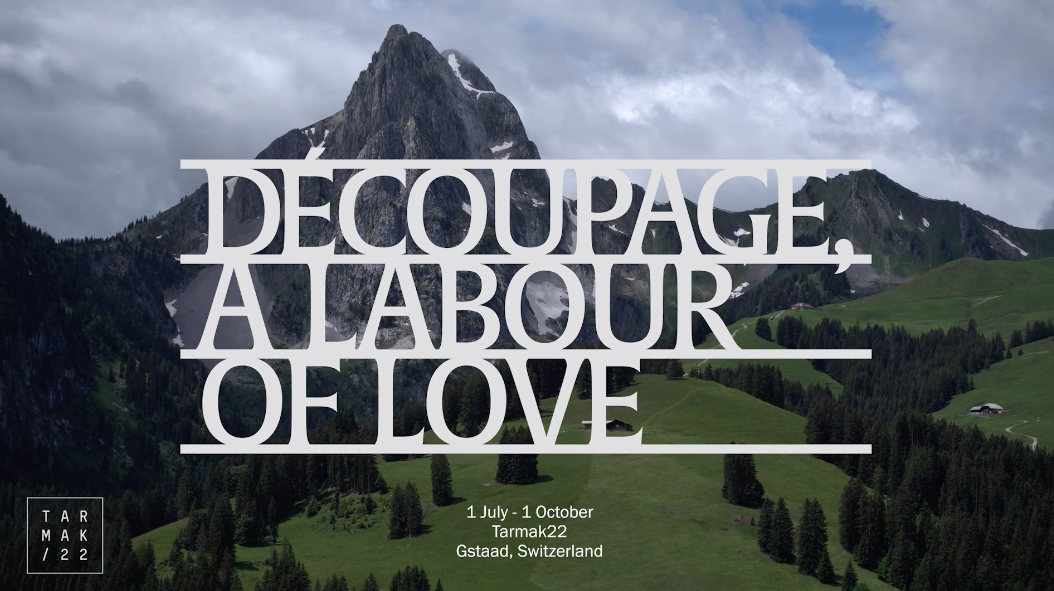Découpage, A Labour of Love
1 July – 17 October 2021
Tarmak22 is pleased to present the exhibition Découpage, A Labour of Love, a display of over 150 historical paper-cuts made in the 19th and 20th Century by modern Swiss masters. Tracing the origins and development of the paper cut-out as a principal motif, the exhibition honours the craft’s history and its Swiss heritage alongside a selection of contemporary works brought to Gstaad by collaborators Sadie Coles, David Zwirner and Gagosian.
Idyllic scenes of cows being brought up the mountains, floral displays on wooden chalets and geometric, heart-shaped compositions; these are just a few of the poetic, alpine motifs depicted in traditional découpage works. Having originated in the Far East, paper-cutting was first recorded approximately 2000 years ago, in China, Egypt and Japan, predominantly depicting religious subject matter. Once it reached Europe in the early 19th century, the medium became primarily concerned with romantic motifs, specifically with silhouette portraits, which became highly sought after by wealthy, aristocratic families. Paper-cutting was then considered part of an ‘upper class’ education, along with learning how to play the piano or drawing.
Once the practice arrived to more remote areas, such as here in the Swiss alps, it moved away from its romantic and glamorous associations. Using a penknife and paper, it was a humble and accessible medium to depict the slow, simple and at times laborious way of life in the Alps as well as a popular form of passing time during long winter nights in the mountains.
After the work of Johann-Jakob Hauswirth — considered the ‘father’ of Swiss paper-cutting — was discovered forty years after his death in 1871, the Musée du Vieux Pays-d’Enhaut in Château-d’Oex made a commitment to preserve the artistic heritage of découpage in the area from its foundation in 1922. This has enabled the practice to receive the attention it deserves and thus remains very much alive in the region today.
With a generous loan from the Musée du Vieux Pays-d’Enhaut, this exhibition displays the collection of the Chateau de Rougemont, which includes a significant body of work by the three local masters Johann-Jakob Hauswirth (1809-1871), Louis David Saugy (1871-1953) and Christian Schwizgebel (1914-1993) alongside their contemporaries.
These exceptional pieces will be shown with those of several local artists, amongst them Margherita Agnelli de Pahlen (b. 1955) and the prolific Anne Rosat (b. 1935), who is recognised as one of the most acclaimed artists working with the medium today.
Tarmak22 has invited collaborators Sadie Coles, David Zwirner and Gagosian to bring contemporary artworks that create a dialogue with the traditional ‘découpages’. Amongst the artists in the contemporary selection are Richard Prince (b.1949) and Jockum Nordström (b.1963), whose practices echo the collage-like qualities found in paper-cuts – as well as the French artist Balthus (1908-2001) and his spouse Setsuko Klossowska de Rola (b.1943).
Découpage, A Labour of Love was made possible thanks to the dedication and support of Marcel Bach, whose outstanding historical collection is on display as part of the exhibition. It is thanks to him that we have also been able to involve Hans-Jürgen Glatz, the passionate collector behind the Hüsy Collection, and Hannes Moor from the Saanen Museum. It is through the contributions from all of the above-mentioned participants that Tarmak22 is able to bring together one of broadest and largest presentations on the subject of découpage in Switzerland to date.
Découpage, A Labour of Love
1 July – 17 October 2021
Tarmak22 is pleased to present the exhibition Découpage, A Labour of Love, a display of over 150 historical paper-cuts made in the 19th and 20th Century by modern Swiss masters. Tracing the origins and development of the paper cut-out as a principal motif, the exhibition honours the craft’s history and its Swiss heritage alongside a selection of contemporary works brought to Gstaad by collaborators Sadie Coles, David Zwirner and Gagosian.
Idyllic scenes of cows being brought up the mountains, floral displays on wooden chalets and geometric, heart-shaped compositions; these are just a few of the poetic, alpine motifs depicted in traditional découpage works. Having originated in the Far East, paper-cutting was first recorded approximately 2000 years ago, in China, Egypt and Japan, predominantly depicting religious subject matter. Once it reached Europe in the early 19th century, the medium became primarily concerned with romantic motifs, specifically with silhouette portraits, which became highly sought after by wealthy, aristocratic families. Paper-cutting was then considered part of an ‘upper class’ education, along with learning how to play the piano or drawing.
Once the practice arrived to more remote areas, such as here in the Swiss alps, it moved away from its romantic and glamorous associations. Using a penknife and paper, it was a humble and accessible medium to depict the slow, simple and at times laborious way of life in the Alps as well as a popular form of passing time during long winter nights in the mountains.
After the work of Johann-Jakob Hauswirth — considered the ‘father’ of Swiss paper-cutting — was discovered forty years after his death in 1871, the Musée du Vieux Pays-d’Enhaut in Château-d’Oex made a commitment to preserve the artistic heritage of découpage in the area from its foundation in 1922. This has enabled the practice to receive the attention it deserves and thus remains very much alive in the region today.
With a generous loan from the Musée du Vieux Pays-d’Enhaut, this exhibition displays the collection of the Chateau de Rougemont, which includes a significant body of work by the three local masters Johann-Jakob Hauswirth (1809-1871), Louis David Saugy (1871-1953) and Christian Schwizgebel (1914-1993) alongside their contemporaries.
These exceptional pieces will be shown with those of several local artists, amongst them Margherita Agnelli de Pahlen (b. 1955) and the prolific Anne Rosat (b. 1935), who is recognised as one of the most acclaimed artists working with the medium today.
Tarmak22 has invited collaborators Sadie Coles, David Zwirner and Gagosian to bring contemporary artworks that create a dialogue with the traditional ‘découpages’. Amongst the artists in the contemporary selection are Richard Prince (b.1949) and Jockum Nordström (b.1963), whose practices echo the collage-like qualities found in paper-cuts – as well as the French artist Balthus (1908-2001) and his spouse Setsuko Klossowska de Rola (b.1943).
Découpage, A Labour of Love was made possible thanks to the dedication and support of Marcel Bach, whose outstanding historical collection is on display as part of the exhibition. It is thanks to him that we have also been able to involve Hans-Jürgen Glatz, the passionate collector behind the Hüsy Collection, and Hannes Moor from the Saanen Museum. It is through the contributions from all of the above-mentioned participants that Tarmak22 is able to bring together one of broadest and largest presentations on the subject of découpage in Switzerland to date.

